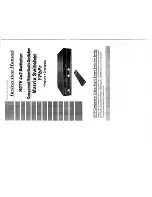
64
Extreme Networks Consolidated "e" and "i" Series Hardware Installation Guide
Summit Switch Models
Port Connections
A Summit 200-24 or 200-48 switch has either 24 or 48 10BASE-T/100BASE-TX ports using RJ-45
connectors for communicating with end stations and other devices over 10/100Mbps Ethernet.
A Summit 200-24fx/200-24fx-TAA switch has 24 100BASE-FX ports for communicating with end
stations or other devices over 100Mbps Ethernet.
The switch also has four Gigabit Ethernet uplink ports, of which only two can be used at any one time.
These combination ports are labeled 25 and 26 on the front panel of the Summit 200-24 or 200-24fx and
labeled 49 and 50 on the front panel of the Summit 200-48. Two of the ports are 10/100/1000BASE-T
ports using RJ-45 connectors. The other two ports are unpopulated receptacles for mini-GBICs (SFPs),
using optical fibers with LC connectors. All models of the Summit 200 support the use of 1000BASE-SX,
1000BASE-LX, 1000BASE-ZX, or 1000BASE-BX mini-GBICs.
The uplink ports can be used as the interconnect ports in a Summit switch stacked configuration. For
more information about configuring and operating a Summit switch stack, see the
ExtremeWare Software
User Guide
.
NOTE
Only mini-GBICs that have been certified by Extreme Networks (available from Extreme Networks)
should be inserted into the mini-GBIC receptacles on the Summit 200 series switch.
Summit 200 Automatic Failover
The Summit 200 switch supports an automatic failover from an active fiber port to a copper backup or
from an active copper port to a fiber port. If one of the uplink connections fails, the Summit 200 uplink
connection automatically fails over to the second connection. On the Summit 200-24 and 200-48
switches, the preferred medium is fiber and cannot be configured. On the Summit 200-24fx and Summit
200-24fx-TAA switches, the switch determines whether the port uses the copper or fiber connection
based on the order in which the connectors are inserted into the switch.
On the Summit 200-24, 200-24fx, 200-24fx-TAA switches, ports 25 and 26 are the Gigabit Ethernet ports
that have the redundant PHY interfaces. On the Summit 200-48 switch, ports 49 and 50 have the
redundant PHY interfaces. Each port has one mini-GBIC and one copper 1000BASE-T connection.
To set up a redundant link on one of the uplink ports, connect the active fiber and 1000BASE-T links to
both the RJ-45 and mini-GBIC interfaces of that port.
Uplink Redundancy on the Summit 200-24 Switch and Summit 200-48 Switch
On the Summit 200-24 and 200-48 switches, Gigabit Ethernet uplink redundancy follows these rules:
•
Only one interface on each port can be active at a time. For example, on port 25 of the Summit
200-24 switch, with both the mini-GBIC and 1000BASE-T interfaces connected, only one interface can
be activated. The other is inactive. If both interfaces are connected, the switch defaults to the fiber
interface (mini-GBIC) and deactivates the 1000BASE-T interface.
•
If only one interface is connected, the switch activates the connected interface.
•
To set up a redundant link on an uplink port, connect the active fiber and 1000BASE-T links to both
the RJ-45 and mini-GBIC interfaces of the port. The switch defaults to the fiber link. If the fiber link
fails during operation, the switch automatically activates the redundant 1000BASE-T link.
Summary of Contents for e" series
Page 18: ...18 Extreme Networks Consolidated e and i Series Hardware Installation Guide Preface...
Page 19: ...Part 1 Common Features...
Page 20: ......
Page 25: ...Part 2 Site Planning...
Page 26: ......
Page 56: ...56 Extreme Networks Consolidated e and i Series Hardware Installation Guide Site Preparation...
Page 57: ...Part 3 Summit Switch...
Page 58: ......
Page 137: ...Part 4 Alpine Switch...
Page 138: ......
Page 213: ...Part 5 BlackDiamond Switch...
Page 214: ......
Page 303: ...Part 6 Switch Operation...
Page 304: ......
Page 307: ...Part 7 Appendixes...
Page 308: ......
















































